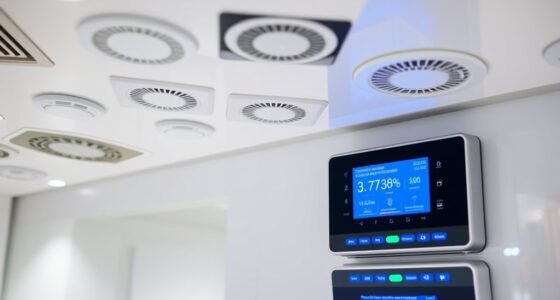Demand-controlled ventilation helps you balance energy savings with indoor air quality by automatically adjusting airflow based on occupancy and pollutant levels. It uses sensors to detect CO₂, VOCs, and other pollutants, turning ventilation on or off as needed. This prevents over- or under-ventilation, saving energy and ensuring fresh air for comfort and health. Keep exploring to discover how this smart system can benefit your building’s efficiency and indoor environment.
Key Takeaways
- DCV adjusts ventilation based on real-time occupancy and air quality sensors, optimizing indoor air quality and energy use.
- It prevents over-ventilation, reducing energy waste while maintaining healthy indoor environments.
- By scaling ventilation dynamically, DCV supports compliance with air quality standards and building regulations.
- The system enhances occupant comfort and health through balanced fresh air delivery and pollutant control.
- Implementing DCV leads to energy savings and reduced carbon footprint, aligning with sustainability goals.

Demand-controlled ventilation (DCV) is an energy-efficient system that adjusts airflow based on occupancy levels and indoor air quality. When you implement DCV, you’re taking a proactive approach to maintaining a healthy indoor environment while minimizing energy consumption. Unlike traditional ventilation systems that run at constant speeds, DCV uses sensors to monitor occupancy and air quality, ensuring that fresh air is supplied only when needed. This targeted approach helps enhance air quality and reduces waste, making your building more sustainable and cost-effective.
By focusing on air quality enhancement, DCV ensures that the air you breathe remains clean and healthy. Sensors detect levels of carbon dioxide, volatile organic compounds, and other pollutants, triggering ventilation only when indoor air deteriorates beyond preset thresholds. This prevents over-ventilation, which can waste energy, and under-ventilation, which can compromise health. As a result, you get a balanced environment where fresh air is delivered precisely when it’s needed, improving comfort and reducing the risk of respiratory issues caused by stale air. With DCV, you’re not just saving energy—you’re actively creating a healthier space for occupants.
DCV uses sensors to ensure fresh air only when needed, promoting healthier, more comfortable indoor environments.
Energy efficiency is at the core of demand-controlled ventilation. Since the system adjusts airflow dynamically, it consumes less energy than constant-volume systems. When occupancy drops, the system scales back, cutting down on power usage for fans and ventilation equipment. Conversely, when more people are present or air quality drops, it ramps up to maintain ideal conditions. This intelligent operation means you’re not paying to cool, heat, or ventilate empty spaces, which considerably lowers your energy bills. Over time, these savings can add up, making DCV a smart investment for buildings aiming to reduce their carbon footprint while maintaining high indoor air quality.
Implementing DCV also simplifies compliance with building codes and standards that emphasize indoor air quality. It provides real-time data on air quality parameters, allowing you to monitor and adjust operations as needed. This not only ensures a healthier environment but also supports sustainability goals by reducing unnecessary energy use. Additionally, because DCV systems can be integrated with existing HVAC infrastructure, upgrading your building’s ventilation becomes a seamless process that enhances both efficiency and indoor air quality. Incorporating lifestyle improvements, such as better work environments, can further enhance occupant well-being and productivity.
Frequently Asked Questions
How Does Demand-Controlled Ventilation Affect Overall Building Maintenance Costs?
Demand-controlled ventilation can lower your overall building maintenance costs by optimizing system operation and reducing energy use. It adjusts ventilation based on occupancy, which decreases wear and tear on equipment, leading to fewer repairs. However, it may increase system complexity, requiring more specialized maintenance and monitoring. This balance means you save on energy but might face higher costs for maintaining the more advanced system.
Can Demand-Controlled Ventilation Be Integrated With Existing HVAC Systems Easily?
You can typically integrate demand-controlled ventilation with existing HVAC systems, but retrofit challenges may arise. You’ll need to assess system compatibility first; older systems might require upgrades or additional controls. Ensuring seamless integration involves proper planning and possibly consulting professionals. While it’s doable, expect some initial effort and investment to address retrofit challenges, but the long-term benefits of energy savings and improved air quality make it worthwhile.
What Are the Long-Term Energy Savings Associated With Demand-Controlled Ventilation?
You’ll see long-term energy savings with demand-controlled ventilation as it optimizes airflow based on occupancy, improving energy efficiency. This adaptive system reduces unnecessary heating, cooling, and fan use, leading to significant cost reductions over time. By adjusting ventilation in real-time, you minimize waste and lower utility bills, making your building more sustainable and cost-effective while maintaining healthy indoor air quality.
How Does Demand-Controlled Ventilation Impact Occupant Comfort and Productivity?
You’ll notice improved occupant comfort and productivity with demand-controlled ventilation because it adjusts airflow based on real-time air quality and thermal comfort needs. This means fresher air and a consistent temperature, reducing drafts and hotspots. By maintaining ideal air quality, you’ll feel more alert and focused, leading to better work performance. The system helps create a healthier environment, making it easier to stay comfortable and productive throughout the day.
Are There Specific Building Types or Climates Where Demand-Controlled Ventilation Is Most Effective?
You’ll find demand-controlled ventilation most effective in buildings with variable occupancy, like offices, schools, and gyms, especially in climates with significant temperature swings. Climate-specific applications matter because humid or hot environments benefit from adjusting airflow, reducing energy use while maintaining air quality. Building type considerations include ensuring systems are compatible with the space’s needs, so you optimize comfort, energy efficiency, and indoor air standards effectively.
Conclusion
By adjusting ventilation based on actual needs, you strike a balance between energy savings and air quality. It’s like choosing between a quick, invigorating breeze and a heavy, energy-draining storm—you get the fresh air without wasting power. Demand-controlled ventilation lets you enjoy a healthier indoor environment without the guilt of excess energy use. So, next time you think about ventilation, remember: smarter choices deliver cleaner air and lower bills, proving you don’t have to sacrifice comfort for efficiency.









